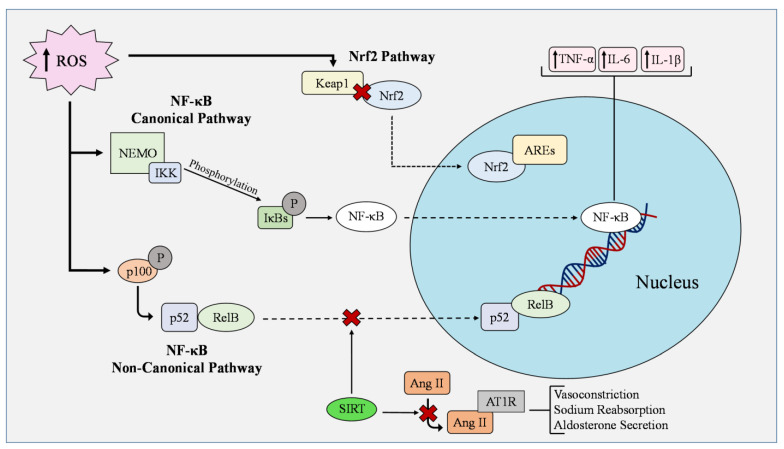Figure 2.
Antioxidant and oxidant pathways in endothelial cells in cardiometabolic disorders. In the nuclear factor kappa B (NF-κB) canonical pathway, IkappaBs (IκBs) are phosphorylated by the IκB kinase (IKK) complex in response to inflammatory signals activating the NEMO-binding domain. The degradation of the IκBs then allows the nuclear transport of NF-κB proteins, which initiates gene expression. In contrast, the non-canonical pathway aims to activate the NF-kB transcription factor RelB/p52 complex by phosphorylating and processing p100 into p52, where it can then bind to RelB. NF-κB regulates the expression of tumor necrosis factor α (TNF-α), interleukin-6 (IL-6), and interleukin-1β (IL-1β). The Nrf2/Keap1–ARE pathway is one of the essential antioxidant pathways for ROS management and it is activated by laminar sheer stress in ECs. Under conditions of oxidative stress, ROS interact with Kelch-like-ECH-associated protein 1 (Keap1) and hinders the ubiquitination of nuclear factor erythroid 2 related factor 2 (Nrf2). Nrf2 then translocates into the nucleus and binds to antioxidant response elements (AREs). Keap1 can turn off this signaling if ROS levels decrease. Sirtuin 1 (SIRT1) plays an inhibitory role in regulating the activity of p53 and NF-κB pathways while other family members manipulate the activation of angiotensin II type 1 receptor (AT1R). Angiotensin II (Ang II) activates AT1R through direct binding, leading to vasoconstriction, sodium reabsorption, and aldosterone secretion.

